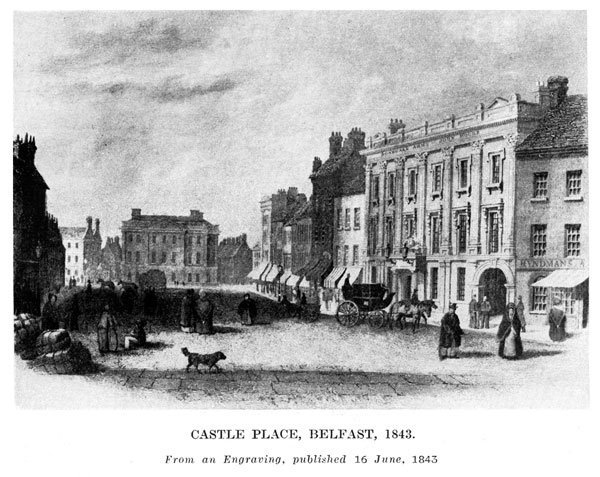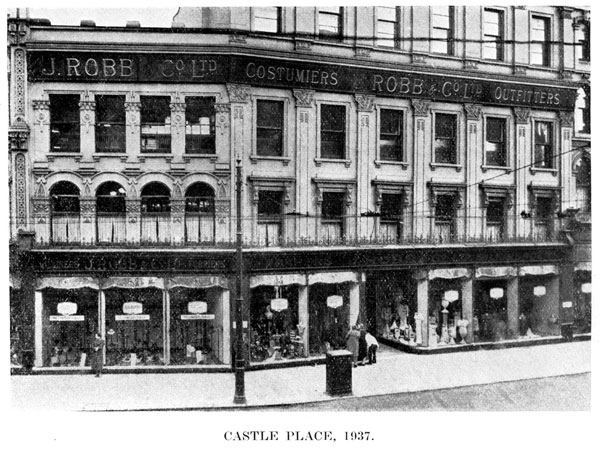THE DONEGALL ARMS.

The Inn, known as the Donegall Arms, was situated on the north side of Castle Place alias The Parade alias Castle Street and played an important part in the social and political life of Belfast from the middle of the eighteenth to the middle of the nineteenth century. In its early career it was a comparatively insignificant structure under the name of The New Inn. Not having sufficient accommodation, on one occasion, the chaise of Lord Antrim was parked on the street and cut and slashed during the dark hours of the night, when the proprietor, Francis Graham, advertised a reward for the apprehension of the culprit without any successful result. Graham carried on the Inn for ten years, 1752-1762; and was succeeded by Adrian von Brackley, 1762-1773; James McKane, 1773-1785; and James Sheridan, 1785-1791.
It was during Sheridan's occupancy that the Donegall Arms was enlarged and rebuilt, 1786, and although the Hotel has been closed for over three quarters of a century, the building still remains, forming a portion of the Haberdashery and Millinery Establishment of John Robb & Co., Ltd.
It is seldom that an old building, in the midst of "change and decay," retains so many of its original features as does the Donegall Arms. During its existence of one and a half centuries, Legg's Lane and the savoury Hercules Lane have been swept away and replaced by Lombard Street and Royal Avenue, as more suited to the requirements of an advancing and progressive community. Paddy Gaw has vanished from his active participation in supplying the sedative of snuff and tobacco, and his shop, once well-known as Paddy Gaw's Corner, wherein many a legal document was witnessed by its proprietor, has become an unintelligible name to most of the present generation. But how many can now locate "Arthur's Corner", or name the personage from whom its name was derived? It was not so-called after any of the Donegall family, in whose pedigree the name so frequently occurs.
In a lease, bearing date 14th May, 1755, from Arthur, 4th Earl of Donegall to Arthur Byrtt, the parcels are:--
"all that messuage or tenement in Broad Street and Bridge Street in Belfast, being a corner tenement in the corner called Arthur's Corner, containing in front 36 feet, with a garden plot and several backhouses, extending backwards to a burgage share of land now or late belonging to John Leathes the Elder."
But notwithstanding both the lessor and the lessee in the above lease are named Arthur, the name Arthur's Corner was not derived from either, but from a previous occupant, Alexander Arthur, who is referred to in a lease of 1722, as follows :--
"... as the said tenement is now improved and built by the late Alexander Arthur, with the dwelling house on said frontage, backhouses, and a tannhouse and pitts."
From Corporate Records we find that Alexander Arthur was it tanner, "admitted and sworne a free Comoner & Marcht stapler of this Corporacon" on 22nd September, 1664.

But though all those changes have occurred during the last century and a half, the Donegall Arms still remains in situ, in a somewhat different dress. The six windows on the first and second floors on the right of the above building are the actual windows out of which the guests of the Donegall Arms looked at the everyday occurrences of Belfast life, including two of more than ordinary interest; the march past of the Volunteers on 14th July, 1792, headed by Major Crawford of Crawfordsburn, in commemoration of the French Revolution, with its imaginary redress of Irish grievances; and six years later, almost to a day, 17th July, 1798, the lifeless body of Henry Joy McCracken, dangling from the gallows on the Market House, as the result of a misguided, youthful ambition.
Inside the building are still to be seen the old painted and varnished shutters that excluded from outward view the gay and festive scenes within, the enumeration of which would occupy more space than is here available. If those old, interior walls could speak what a flood of eloquence would pour forth! Toasts varying in number from twenty to thirty were customary at the festive gatherings, some of which were received with "Three Cheers and Nine Plaudits". But less boisterous meetings were held, as when the 5th Earl of Donegall, Colonel of the Belfast Battalion of Volunteers, held a Reception at the Exchange on 9th June, 1783, and, in the words of Dr. Haliday :-- "Three hundred and sixty vassals and vassalesses, all alive, were present. He led us off at midnight to sup in seven rooms at the Inn."
Two Lords Lieutenant were entertained within its walls, the Duke of Rutland, on 30th July, 1787, and, among those present were Lords Hillsborough, Rawdon, and Jocelyn and the Bishop of Down, when "the usual liberty toasts were drunk on the occasion" ; and Charles, Marquis of Cornwallis, on 7th October, 1799, who, after being enrolled "among the Freemen of this Town", was honoured by a public dinner, to which the Bishop of Down, the Very Rev. William Dickson, D.D., was refused admission, not having "declared himself a friend to the Union".
But a more solemn procedure was transacted within those walls on 21st April, 1799, when a Court Martial sat in the Donegall Arms and, at its meetings between 20th and 30th May, "condemned several prisoners to serve the King of Prussia ". The Court Martial was finally dissolved on the following 12th June.
The house adjoining the Donegall Arms to the west was the Belfast Bank, or as it was colloquially called the Bank of the Four Johns, which was opened on 1st June, 1787, and continued there until 4th November, 1788, when the Bank was removed to a site in Ann Street, now covered by the Whitehall Buildings.
The following advertisement appeared in the Belfast News-Letter :
TO be set immediately or the interest in Lease
to be sold. The house adjoining the Donegall
Arms Inn, lately occupied by the Bank --
Application to be made to Messrs. Ewing,
Holmes & Co.
-- Belfast, November 4th, 1788.
Stewart Banks afterwards resided in this house for a few years.

